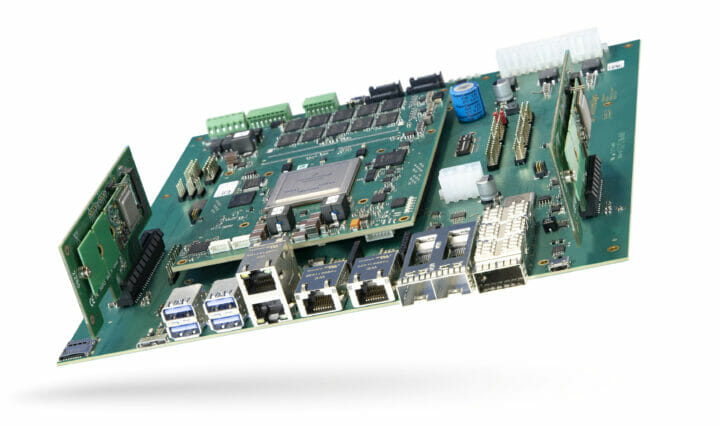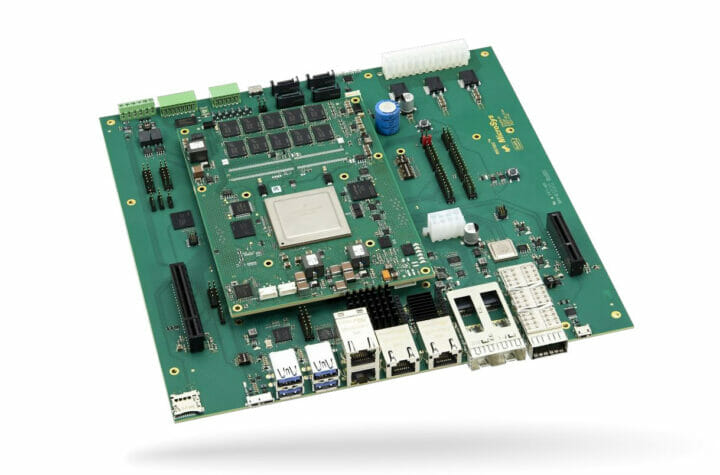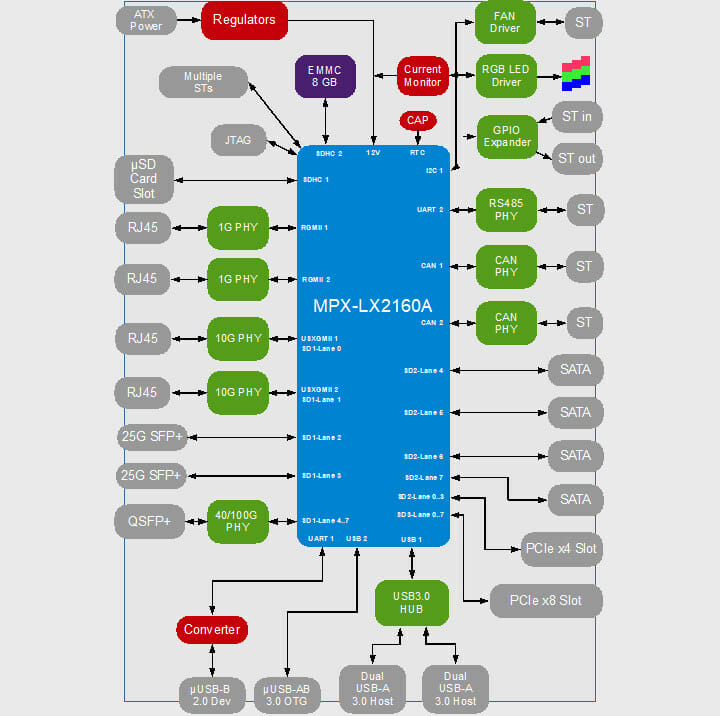MicroSys Electronics miriac AIP-LX2160A embedded platform combines a 16-core Cortex-A72 NXP LX2160A networking processor with up to five Hailo-8 AI accelerator modules delivering up to 130 TOPS of AI inference performance.
The board supports up to 128 GB RAM, up to 4x SATA hard drives, up to 100GbE connectivity, and appears to be especially suited to applications with multiple IP video streams requiring real-time video analytics.
 miriac AIP-LX2160A specifications:
miriac AIP-LX2160A specifications:
- SoC – NXP Layerscape LX2160A with 16 Arm Cortex-A72 cores @ up to 2.2 GHz
- AI accelerators – 2x Hailo-8 M.2 AI Acceleration Modules, upgradeable to up to 5 Modules via NGFF M.2 Key M card
- System Memory – Up to 128 GB DDR4 RAM & optional ECC, up to 3200MT/sec, up to 4 ranks (combined design: 2x discrete & 2x SODIMM)
- Storage
- 4x SATA III ports
- Up to 256 GB eMMC 5.1 flash, additional eMMC device on carrier board
- Up to 2 Gbit Octal SPI Flash at up to 200 MHz (double operation / golden image)
- microSD card socket
- Boot Device: XSPI, eMMC or external microSD card
- Networking
- 2x 1 Gbps RGMII Ethernet RJ45 ports
- 2x 10 Gbps Ethernet RJ45 ports
- 2x 25 Gbps Ethernet SFP+ cages
- 1x 40 Gbps Ethernet QSFP+ cage (configuration option)
- 1x 100 Gbps Ethernet QSFP+ cage (configuration option)
- USB – 4x USB 3.0 host ports, 1x USB 3.0 OTG port
- Serial
- 2x CAN FD
- 3x UART: 1x UART/USB console, 1x TTL, 1x RS485
- Expansion
- PCIe 1x Gen3 x8 (2.5, 5 or 8 Gbps) + 1x Gen3 x4 (2.5, 5 or 8 Gbps)
- 1x Gen3 x4 (2.5, 5 or 8 Gbps)
- 2x I2C, 1x FlexSPI
- All I/O pins available on SEARAY connectors
- Debugging – JTAG debug interfaces for processor and microcontroller
- Misc – Temperature sensors, fan controller, RTC, Management Engine, CPLD, 4x RGB LEDs
- Power Supply – ATX power supply with separate 12 V line, delivering 200 W minimum
- Temperature Range – 0 °C to 70 °C
The hardware just appears to be the existing miriac SBC-LX2160A single board computer combined with 26 TOPS Hailo-8 M.2 modules connected to the PCIe slots via an M.2 adapter. I’m not sure how we reach the number “five”, maybe a card with 3 AI accelerators connected to the PCIe x8 slot, and the other with 2 connected to the PCIe x4 slot. The solution enables high AI computing performance with, for instance, over 6000 FPS on Resnet-50, over 5000 FPS on Mobilenet-V1 SSD, and close to 1000 FPS on YOLOv5m. Microsys provides a Linux BSP, as well as a development kit with a power supply, cables, and a microSD card preloaded with Linux.
The embedded platform targets low-power IIoT and Industry 4.0 edge servers for predictive maintenance, collaborative robotics, video surveillance servers, communication servers for autonomous vehicles in logistics and agriculture, and heavy equipment for construction. The board may also be used in trains with multiple GigE Vision camera streams analyzed in real-time with AI for greater safety and security of passengers and goods.

It should come as no surprise that pricing has not made been publicly made for the solution. Additional information may be found on the product page and press release.
Via LinuxGizmos

Jean-Luc started CNX Software in 2010 as a part-time endeavor, before quitting his job as a software engineering manager, and starting to write daily news, and reviews full time later in 2011.
Support CNX Software! Donate via cryptocurrencies, become a Patron on Patreon, or purchase goods on Amazon or Aliexpress






Size over substance comes to mind here.
Why make such a large board with such a weird layout?
To fit truckload of ports it holds, I guess?
So making a custom PCB layout that fits inside nothing was the best way of doing that?